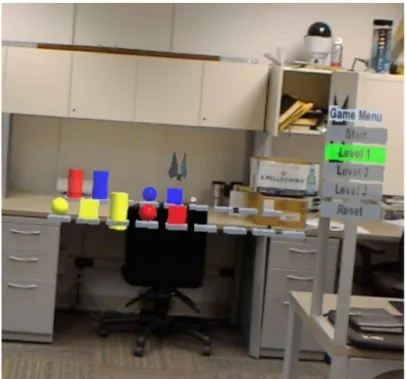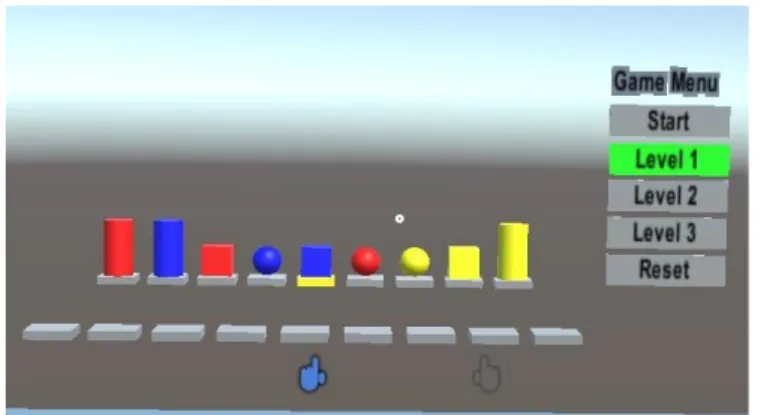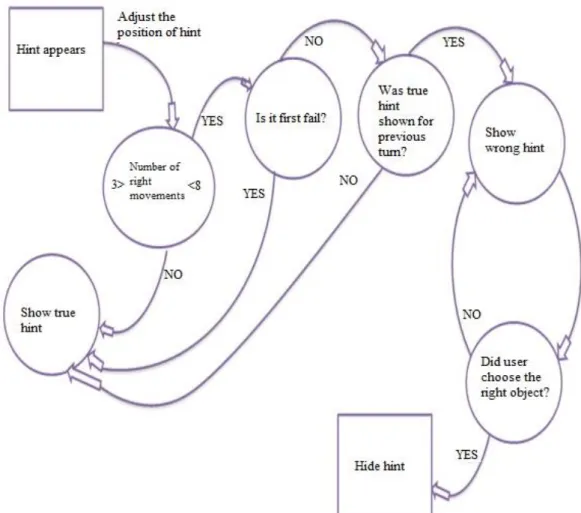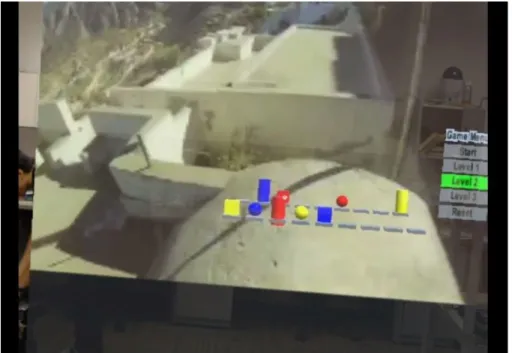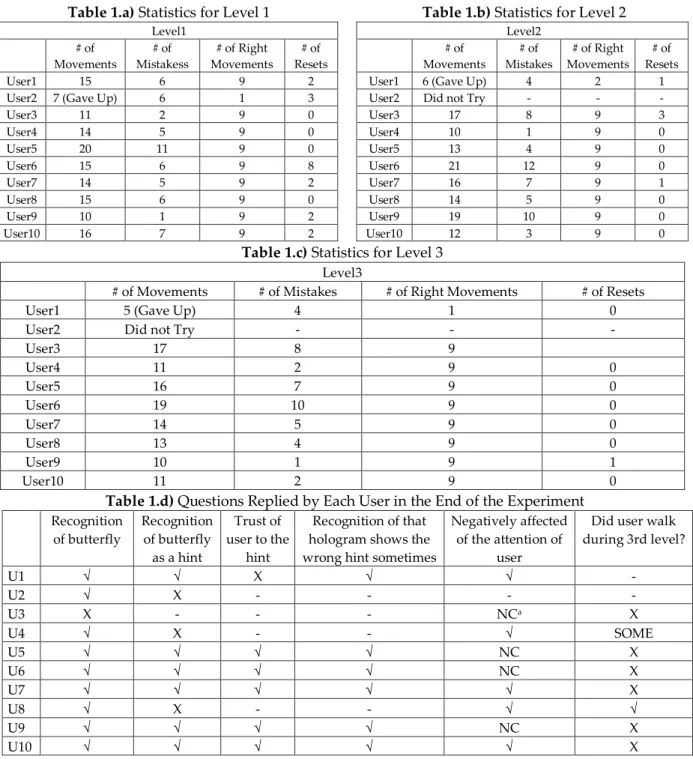RESHAPING HUMAN INTENTION ON HUMAN-MACHINE INTERACTION BY USING HOLOGRAMS
1Kemal ERDOĞAN , 2Akif DURDU , 3Rahime CEYLAN 1kerdogan@ktun.edu.tr, 2adurdu@ktun.edu.tr, 3rceylan@ktun.edu.tr
1,2,3Konya Technical University, Department of Electrical and Electronics Engineering, Konya, TURKEY
(Geliş/Received: 05.11.2020; Kabul/Accepted in Revised Form: 27.11.2020)
ABSTRACT: Decision making could be critically important for people in some situations. People have intentions to choose a side if it is time to make decision. These intentions are strongly related to the knowledge and experience. But sometimes outer effects could reshape their intentions easily. In this paper, an experimental work is studied for Human-Machine Interaction in which if holograms could change or affect the human intention. And also the question which asks whether people trust on a hologram agent while making decision or not is researched. To study this research, a memory game application is developed and this application is run on Microsoft Hololens device. Hololens is used to maintain the Augmented Reality (AR) environment with holograms. An algorithm with a Finite State Machines (FSM) is developed to manage the response of hologram agent while giving hint to the confused users. The accuracy of the hints changes nonlinearly. 3 different game stages are trained on users to see how they are affected by both virtual and real world noises. According to the results, intention of majority of users was affected by the hologram while making the decisions. Also it is observed that some users who were concentrated too much to memorize the order of objects did not realize the hologram, and some few could not understand the actions of hologram.
Key Words: Augmented Reality, Decision Making, Finite State Machines, Human-Machine Interaction,
Intention Reshaping.
İnsan - Makine Etkileşiminde Hologram Kullanılarak İnsan Niyetinin Yönlendirilmesi ÖZ: Karar verme, bazı durumlarda insanlar için kritik derecede önemli olabilir. İnsanların karar verme zamanı geldiğinde taraf seçme niyetleri vardır. Bu niyetler, bilgi ve geçmiş deneyimlerle ilişkilidir. Ancak bazen dış etkiler insan niyetini kolayca yeniden şekillendirebilir. Bu makalede, İnsan-Makine Etkileşimi için deneysel bir çalışma gerçekleştirilmiştir. Burada hologramların insan niyetini değiştirip değiştiremeyeceği araştırılmıştır. Ayrıca insanların karar verirken hologram etmene güvenip güvenmediği de araştırılmıştır. Bu araştırmayı incelemek için bir hafıza oyunu uygulaması geliştirilmiş ve bu uygulama Microsoft Hololens cihazında koşturulmuştur. Hololens, Hologramlarla Artırılmış Gerçeklik (AG) ortamını sağlamak için kullanılmıştır. Sonlu Durum Makineleri (SDM) içeren bir algoritma, kafası karışan kullanıcılara ipucu verirken hologram etmenin tepkilerini yönetmek için geliştirilmiştir. İpuçlarının doğruluğu doğrusal olmayan bir şekilde değişmektedir. Kullanıcıların hem sanal hem de gerçek dünya seslerinden nasıl etkilendiklerini görmek için 3 farklı oyun aşaması tasarlanmıştır. Çalışmadan elde edilen sonuçlara göre, kullanıcıların çoğunluğunun niyeti karar verirken hologramdan etkilenmiştir. Ayrıca nesnelerin sırasını ezberlemek için konsantre olan bazı kullanıcıların hologramın farkına varamadığı, bazılarının da hologramın eylemlerini anlayamadığı görülmüştür.
Anahtar Kelimeler: Artırılmış Gerçeklik, Karar Verme, Sonlu Durum Makineleri, İnsan-Makine Etkileşimi,
1. INTRODUCTION
People make decisions when they are facing up to a fork in situations. These situations are composed of three parts; firstly there has to be more than one option in front of the person. As an example situation is that coming to a fork while going on an unknown road. Will you take the right or the left path? Additionally the person could have expectations about these options. These expectations are formed according to beliefs and probabilities. Degree of beliefs and as the third part, experiences have important roles while making decisions. People make estimations using past assessments. These all 3 parts form the structure of decision making (Hastie et al., 2010).
It was studied before that if a person’s intention while making decision could be reshaped or changed by using robots (Durdu et al., 2012). Using holograms for this mission instead of robots is a novel idea as the Human Machine Interaction (HMI). According to our knowledge this type of research had not been tried before this.
Besides, several researches have been made to see the degree of trust of users on robots and factors affecting the interaction between robot and human but nothing have been studied on holograms (Hancock et al., 2011; Freedy et al., 2007). In this work, the degree of trust was not experienced but it was simply practiced if the user trusts on a hologram agent while making decision or not.
Microsoft’s Hololens device is used to maintain the holographic environment for this study (Microsoft, 2019). An Augmented Reality (AR) application is developed for Hololens. This AR application is the experimental setup for the study. A screenshot of Hololens device is given in Figure 1.
Importance of AR is considerably increasing because today holograms are getting much more place in our life than yesterday. AR devices and applications are developing. Microsoft has an application store for Hololens. Head Mounted Displays (HMDs) like Hololens are very popular in AR and this is a very competitive market.
2. RELATED WORKS
2.1. Intention Reshaping or Affecting Decision Making
Some researches on Human Intention Reshaping or Changing Human Intentions by using robots are studied before. Mobile robots were used to change previously estimated human intentions (Durdu et al., 2012). Experiments were practiced in a specially designed real human robot environment. In the experimental scenario of the study, a human walks in a room, where a set of autonomous robots and other objects are placed in. These robots are formed like mobile chair and mobile stairs. Other elements in the room are bookshelf, coffee table, computer and cameras. Computer observes motions, positions and postures of the human with the connected cameras. Interactions are processed by computer with the use of Observable Operator Models method to estimate human intentions. According to these intention estimations, robots are controlled to change the intention of the human in the room.
2.2. IntentionReshaping or Affecting Decision Making
AR systems are defined as they have three characteristics in a survey in 1997. These systems should combine virtual and real environment. Also it is added as; they are interactive systems in real time and registered in 3D (Azuma, 1997). Taxonomy was declared for AR, VR and Mixed Reality (MR) in 1994 and stated as MR contains AR but today it is common AR and MR definitions could be used as substitute for another (Milgram and Kishino, 1994). Wearable technologies for AR and VR are developing but Hololens is a very new wearable device which was released in 2016 and according to our knowledge it has not used to link any interaction between human and machines with the aim of reshaping human intention or affecting decision making.
There is a study aiming to enhance the interaction between Hololens and user (Funk et al., 2017). Authors used Kinect sensor to allow users interacting naturally with holograms in AR environment on Hololens. They also prepared and gave five different examples of gestures that could be used for a natural interaction for Hololens.
There are also different interaction models developed which offers interaction between users in AR environment. These users could be connected to the AR environment with HMDs, tablets or PCs (Chen
et al., 2015).
3. MATERIALS AND METHOD
The experimental setup is designed to be like a game. A person user is wanted to play a memory game in this setup. The idea of this game is that user is being wanted to make decisions, in other words user would face up to a fork and has to make decision to choose a side.
To achieve this target, a kind of difficult memory game application for Hololens was prepared. In this memory game 9 different shaped and colored objects are present. When user starts the game, lights are blinking under these objects in a particular and randomized order (Figure 2).
User is wanted to memorize this order, and he/she is wanted to select the objects in this order. As user selects the objects with the order in his/her memory, objects are getting lined up on the tables closer to him/her. User would be counted successful, when right object is chosen in every movement. If user fails to select the right object, a hologram appears in the scene. Hologram tries to give hint to the user. This hologram is a butterfly. When the hologram appears butterfly is flying around the scene and game objects. And finally it perches on an object.
Figure 2. Tables under objects blink to show the desired order
A Finite State Machine (FSM) structure has built to control the hologram which gives right hint or wrong hint to the user according to user’s movements. It is prepared to prove that a hologram can reshape human’s intention or affect it while making decisions. The FSM mechanism was formed by two main structures. First FSM algorithm has a very simple structure to hide or show the hint (Figure 3).
The other part of the FSM structure which is deciding to give right or wrong hint to the user was designed to work with a more complex algorithm. It is observing user’s movements and collecting data about user’s successful movements, number of total movements, number of fails, when the true hint or wrong hint shown to the user (Figure 4).
It does not give right hint or wrong hint to the user every time. If the hint was given without a complex algorithm or if it was always given right or wrong hint repeatedly, user would easily solve and understand that. Then user would make decisions quickly without thinking, as the hint shows or opposite of the hint shows.
With that result there would not be any interaction between human and hologram. For example in the experiments, at the beginning stages of developing the application, hint was showing true hint at first but then it was always showing the wrong hint. At this point it was observed that user never choose the object that the hint shows, because user learned that hint always gives the wrong hint.
The aim is testing that, if user completely minds the hologram’s movements or has the hologram any effects on human’s intention while making the decision. To prove this the memory game was designed a little harder. It has 9 objects in total and user needs to memorize the order of these objects nearly in 5 seconds.
Experiments showed that most of people could not memorize after 4th or 5th object. At this time user comes to a fork and hint becomes very useful for the user. When the hologram shows the right hint at this point, user could think he was already inclined to choose that right object like he was remembering something around that object. But if the hologram gives the wrong hint and the user also obey both wrong and right hints, this situation will obviously prove that human user’s intention is changed by hologram.
Figure 4. FSM Structure which is deciding to give right or wrong hint to the user
Additionally, with the aim of making the game harder and mind confusing, three different levels are prepared for the game application. Some outer physical actions and virtual scene effects are added on the basic game environment in 2nd and 3rd levels. Also answers of the users are recorded and success rates are measured for every level to compare how accuracy of the user is affected with the noises.
1st level is the basic level and users are getting used to the game and environment. In 1st level user does not face up with an unordinary situation. Only goal for the user is to memorize the order of the blinking lights for the elements in this level. In 2nd level a virtual noise is applied; a big size bouncy video suddenly starts in about 5th second of the game to confuse the user while he was trying to memorize the order of the objects (Figure 5). And lastly in 3rd level user is disturbed with a real world action. User is wanted to walk forward or backwards to observe that if user both minds the real world and virtual world together and if real world movements confuses his motivation on focusing to the virtual world or not. Also in 3rd level the plane where the gaming objects settle on is waving with a period of time to make it harder.
Experiments were done in Ohio State University PCVLAB with 10 different people. Before doing experiments they are all educated about how to use Hololens device with the application named as “Learn Gestures” that was already prepared by Microsoft for this purpose.
Figure 5. A large scale video which is recorded with a POV cam suddenly appears behind game scene.
4. RESULTS AND DISCUSSION
Participating users are all asked if they realized a butterfly hologram appears when they make mistake. Some of them were very well concentrated on memorizing the order of objects, these type users replied this question they did not realized anything. Majority of users declared that they saw the butterfly hologram was trying to give hint when they go wrong. And some of the users replied there were something in background but they did not consider it was a hint (Table.1).
According to the results, 90% of users recognize the butterfly hologram during the game but 33% of these users could not recognize that the butterfly hologram was giving hint to them about next possibly true movements. 83% of the remaining users, who recognized the hologram butterfly, trusted in the butterfly’s hints. They have followed the hint and declared that they had changed their mind according to the hints given by the hologram. One of the participants also stated as he recognized that the hints of the hologram butterfly are doubtful and he added he did not follow the hints as the levels of game progressed.
Table 1.a) Statistics for Level 1 Table 1.b) Statistics for Level 2 Level1 # of Movements # of Mistakess # of Right Movements # of Resets User1 15 6 9 2
User2 7 (Gave Up) 6 1 3
User3 11 2 9 0 User4 14 5 9 0 User5 20 11 9 0 User6 15 6 9 8 User7 14 5 9 2 User8 15 6 9 0 User9 10 1 9 2 User10 16 7 9 2 Level2 # of Movements # of Mistakes # of Right Movements # of Resets
User1 6 (Gave Up) 4 2 1
User2 Did not Try - - -
User3 17 8 9 3 User4 10 1 9 0 User5 13 4 9 0 User6 21 12 9 0 User7 16 7 9 1 User8 14 5 9 0 User9 19 10 9 0 User10 12 3 9 0
Table 1.c) Statistics for Level 3
Level3
# of Movements # of Mistakes # of Right Movements # of Resets
User1 5 (Gave Up) 4 1 0
User2 Did not Try - - -
User3 17 8 9 User4 11 2 9 0 User5 16 7 9 0 User6 19 10 9 0 User7 14 5 9 0 User8 13 4 9 0 User9 10 1 9 1 User10 11 2 9 0
Table 1.d) Questions Replied by Each User in the End of the Experiment
Recognition of butterfly Recognition of butterfly as a hint Trust of user to the hint Recognition of that hologram shows the wrong hint sometimes
Negatively affected of the attention of
user
Did user walk during 3rd level? U1 √ √ X √ √ - U2 √ X - - - - U3 X - - - NCa X U4 √ X - - √ SOME U5 √ √ √ √ NC X U6 √ √ √ √ NC X U7 √ √ √ √ √ X U8 √ X - - √ √ U9 √ √ √ √ NC X U10 √ √ √ √ √ X
The 33% of the users who did not recognize the butterfly or the butterfly was giving hint, were the highest scored users. This shows that these users were highly concentrated on memorizing the order of the blinking lights. So they did fewer mistakes and they did not recognize the butterfly hologram was giving hint. They declared there was a butterfly in the background but it was only a background animation or something like that.
Also all users were wanted to walk forward or backwards while playing the game level 3 but only 20% of the users practiced it. But even these users could not practice walking as it should be. They only took a few steps forward.
5. CONCLUSION
In this paper an AR application was developed for an AR environment with the use of Hololens. The application prepares a gaming environment which uses holograms instead of robots with the aim of interaction between Human and Hologram as HMI. Users were wanted to memorize the order of the blinking objects in the beginning of the game then users were wanted to put them in a right order. While users were trying to do this successfully, a hologram tried to give hints nonlinearly. Sometimes hologram tried to misdirect the user. At this point human intention reshaping or affecting the decision making of human was realized. This study shows that holograms are able to reshape the intention of the user. With this result, target of the study was accomplished successfully.
On the other hand this study showed that it is very difficult to handle real world and virtual world movements together. None of the users made it successfully.
This study would be enhanced by using real time live holograms. Also AI techniques could be used to develop algorithms to control hologram. Another idea could be that real world noises could be changed.
It is planned to build the similar memory game environment with a robotic arm and effects of holograms and robots would be compared in Human Machine Interactions.
6. ACKNOWLEDGEMENT
Authors would like to thank to Konya Technical University and Selçuk University BAP Offices for their support to the project numbered as 16101010 and TUBITAK for their support to the 2214-A project numbered as 1059B141600796. Also authors are thankful to The Ohio State University PCVLAB and Prof. Dr. Alper YILMAZ for their support and use of facilities.
REFERENCES
Azuma, R. T., “A Survey of Augmented Reality”, Teleoperators and Virtual Environments 6, 4 (August 1997), 355-385
Chen, H., Lee, A. S., Swift, M. and Tang, J. C., 2015. “3D Collaboration Method over HoloLens™ and Skype™ End Points”, In Proceedings of the 3rd International Workshop on Immersive Media Experiences (ImmersiveME '15). ACM, New York, NY, USA, 27-30.
Durdu, A., Erkmen, I. and Erkmen, A. M., "Observable operator models for reshaping estimated human intention by robot moves in human-robot interactions", 2012 International Symposium on Innovations in Intelligent Systems and Applications, Trabzon, 2012, pp. 1-5.
Freedy, A., DeVisser, E., Weltman, G. and Coeyman, N., "Measurement of trust in human-robot collaboration," 2007 International Symposium on Collaborative Technologies and Systems, Orlando, FL, 2007, pp. 106-114.
Funk, M., Kritzler, M. and Michahelles. F., 2017. “HoloLens is more than air Tap: natural and intuitive interaction with holograms”, In Proceedings of the Seventh International Conference on the Internet of Things (IoT '17). ACM, New York, NY, USA, Article 31, 2 pages.
Hancock PA, Billings DR, Schaefer KE, Chen JY, de Visser EJ, Parasuraman R., “A Meta-Analysis of Factors Affecting Trust in Human-Robot Interaction”, Hum Factors.2011 Oct;53(5):517-27. Hastie, R., Dawes, R., Rational Choice in an Uncertain World: The Psychology of Judgment and Decision
Making, Second Edition, Pittsburgh, USA, 2010, SAGE pubs, Ch-2 What is decision making? Pp. 23-43
